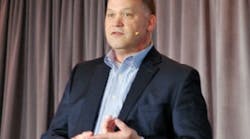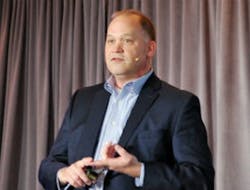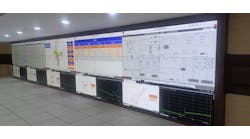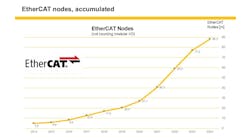“With less-experienced operations personnel, we are running safely and remaining productive even though many of the experienced operators have changed positions, retired or moved on.” 3M’s Rob Sentz describes one result of his group’s digital transformation at Emerson Global Users Exchange in Nashville, Tennessee.
The Film and Material Research Division (FMRD), an internal 3M specialty chemical and adhesive supplier, supports five different manufacturing sites and was looking at its future digital transformation plans.
What it saw was a perfect storm. "There was aging equipment, a less-experienced workforce for many reasons, and health and safety pressure to drive excellence across the globe, all with increasing demands for production," said Robert Sentz, FMRD manufacturing technology engineer at 3M's Cottage Grove plant in Minnesota.
Factory-of-the-future initiatives were looking at different ways to use technology to fill some of these gaps, said Sentz at Emerson Global Users Exchange in Nashville, Tennessee. "3M corporate management created an initiative called PACESetter to drive a common approach to solve these problems across all of our manufacturing sites," he said.
PACESetter, an acronym that includes proprietary process technology, automated processes, connected data, efficiency, and safety and sustainability, is designed to drive quality, service and value to all of its customers.
Fortunately, 3M is very supportive in using advanced technologies to create the most efficient and engaged operations. Innovation is an integral part of 3M's culture; and its many brand names, such as Scotch, Post-it, Scotchgard, Ace and Nexcare, to name a few, were created based on some of its more than 170,000 patents. These and other products are spread throughout more than 230 manufacturing sites in 70 countries that share more than $3.5 billion in yearly R&D and capital investments, including digital transformation.
"It's very difficult to just dive right in to digital transformation," said Sentz. "You must have a solid and robust foundation in place to transform. To start the journey, step one is an assessment of what you have today and where you want to go in the future—a road map. Then you need to build your foundation so you can add the technologies that are much more advanced. You need to define the problems you want to solve and then implement those technologies."
Within FMRD, 3M chose four different key technologies to solve problems in manufacturing, continued Sentz. "Across the corporation, other divisions had other problems and solutions," he said. "For us, one of our four key initiatives was batch automation and advanced control programming, which is key for operations, safety and productivity. Our second initiative was process analytical technology for real-time process analysis of our chemistries and processing. Our third initiative involved workflow and providing an operator-guided work experience—standard work. Our fourth initiative was related to reliability/analytics to extend the life of our equipment."
To execute these factory-of-the-future initiatives, 3M piloted different technologies. "We wanted to prove that it works and get wins," said Sentz. "It's much easier to sell to management if there are wins that show the technology works and has real benefits."
Throwing all four digital-transformation initiatives at one plant was not possible as there was a concern nothing would get done. "No one plant had all the resources to try out the technologies at one time," said Sentz. "I worked with different people in different plants to pilot these technologies. I chose the people based on their interest, their expertise, and whether they had a problem that they wanted to solve."
All sites used and piloted a variety of Emerson digital technologies. For example, the Site 1 team piloted AMS Device Manager including ValveLink and Smart Meter Verification. The Site 2 team piloted Process Analytical Technology (PAT) and Plantweb Advisor. At Site 3, the pilot program team focused on reliability and analytics with wireless vibration, online vibration, Plantweb Insight and Plantweb Optics.
"Once we proved the technology worked, we looked to expand our technology over several years and into the future, said Sentz. "We went to other units, other areas in the site or different plant sites across the globe."
Some of the benefits seen to date include supporting increased production volume, said Sentz. "With less-experienced operations personnel, we are running safely and remaining productive even though many of the experienced operators have changed positions, retired or moved on," he said. "Our reliability program is starting to predict the health of assets before catastrophic failures occur. And we are supporting some key new, specialized processes that have come online where the health of the equipment is critical for us to continue the process."
The perfect storm was real for 3M. "We had been living though it,” said Sentz. "The 3M corporate PACESetter initiative is driving a common approach to implementing these technologies across the corporation. The assessment, building the foundation and defining the roadmap are critical first steps to move forward with your digital transformation. Tracking progress and getting wins is also critical to get funds from management to continue the transformation. As part of the digital transformation, we have aligned with corporate teams for resources and analysis internally, but we have also partnered with key suppliers, such as Emerson, to implement many of our key technologies."







